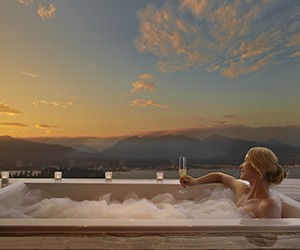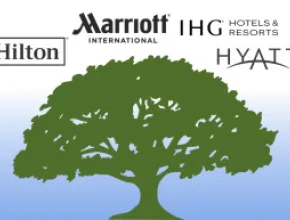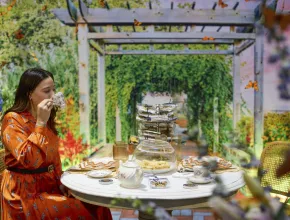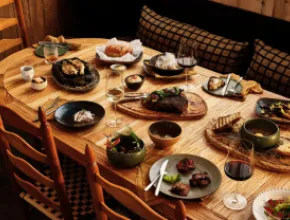Luxury is where every event planner and attendee wants to be. But what version of luxury is right for your meeting? Planners and event sponsors who are most concerned about price usually gravitate toward mid- and upper-end properties or brands. Planning a price-based event tends to focus on the transaction: How many sleeping rooms, how many meeting rooms, which standard setups for which rooms, which banquet menus match the budget, cutting every corner possible.
Luxury is a different animal. All the transactional elements are still there, but the focus shifts to the overall meeting experience. The nuts and bolts of room block and seating setup and meal menus are simply supporting player in the larger picture.
“We do not allow our events to become transactional,” says John Harper, vice president of sales for Ritz-Carlton, one of the first hotel brands to create and define itself as a luxury-only product. “A hotel must have the fundamentals, meeting rooms, lunches, breaks. Luxury goes beyond the fundamentals to create an experience that attendees remember long after the event is over. We’re not in the business of creating transactions, we’re in the business of creating memories for planners and their attendees.”
Every luxury brand has its own version of “luxury is the experience of a meeting, not the mechanics.” And each has its own take on how they envision luxury and how they deliver against the expectations their visions create.
Each of the top hotel brands brings its own spin to luxury and each offers a different set of advantages to planners. Grand Hyatt, for example, tends to have larger properties and meeting spaces, Ritz-Carlton has a wider global reach, Fairmont has more iconic properties, JW Marriott focuses on local flavors, Mandarin Oriental plays on its Asian aesthetic and service heritage. But there is one feature they all agree on: Luxury is an attitude, not a price point.
Fairmont
“Luxury” is highly overused. Planners and attendees want luxury, but too few brands can actually provide it.
“We are very conscientious in trying to understand what the planner and event sponsor are trying to achieve, then delivering against that expectation,” says Jeff Doane, vice president of sales and marketing-Americas, for Fairmont Hotels and Resorts. “Delivering a meeting room with classroom seating for 300 and lunch is a mechanical detail that anybody can do. We focus on the ‘why’ behind your meeting and do our best to help you get there.” Consumer research tells Fairmont that “luxury” is the memory the customer takes home. Every consumer wants to be the hero in their own memory. Fairmont’s role is to create the platform and set the stage for customers to create those memories.
“The burden is on you, the hotel, to figure out what is meaningful to the customer and deliver against it,” he explains. “Our job is to sit down with the planner, and maybe the sponsor, to understand what they want to accomplish. If it’s a sales meeting, your basic goal may be a 10 percent boost in sales. But when we probe, maybe you are depending on a specific sales team to reach the goal. That’s the level of engagement that helps us meet your stated goals and the real goals that might not be obvious the first time around.”
Doane says the Fairmont Pacific Rim, on the waterfront in Vancouver, B.C., best epitomizes Fairmont’s vision of luxury.
Grand Hyatt
“The luxury meeting attendee, like the luxury traveler, is expecting more than the norm, something special and out of the ordinary that they can remember, talk about, maybe brag about,” says Gus Vonderheide, vice president global sales–Americas, for Hyatt Hotels and Resorts. “Other brands that try to do this are typically in the 300- to 400-room range. We have Grand Hyatts [that are] 1,000 rooms and bigger with all the flexibility of boutique luxury properties.”
Being the largest meeting property in most locales gives Grand Hyatt meeting concierges (the brand's dedicated meetings assistants) more clout than the typical convention sales rep, Vonderheide says. Back of the house tours, local landmarks, historic government buildings—very little is off-limits when it comes to tailoring group experiences. DMCs and local CVBs tend to be more responsive when one of their biggest supporters comes calling with a special request for a specific group.
Size also carries advantages on the F&B side of the event. Executive chefs at luxury properties routinely tweak and tailor group menus. Grand Hyatt offers a Personal Preference option that lets diners give personal dinner orders in groups of 500 and larger.
“Our brick and mortar lend themselves to tremendous productions,” Vonderheide says. “We have the facilities and staff to put on major productions, something a competitor’s smaller luxury offering could probably not offer. Size and capabilities give us a strong competitive advantage.”
Vonderheide named the Manchester Grand Hyatt in San Diego as a prime example of what Grand Hyatt does best in the luxury MICE market.
PageBreak
JW Marriott
Meeting attendees, like leisure travelers, are moving from material rewards to experiential rewards. That shift is pushing property event teams to focus more closely on event sponsors’ culture as the key to helping them meet event goals. Not just the stated goals, but the underlying goals that are so deeply rooted in the organization’s culture that sponsors may not even think of mentioning them in event planning sessions.
“Company culture is a basic part of the purpose for every event,” says Ryan Eddy, senior director, Americas sales and marketing–lifestyle and luxury brands for JW Marriott. “It’s not just the planner’s objectives that we have to meet, it’s the sponsor’s objectives and those are always immersed in the sponsor’s own culture. They may be trying to promote networking, build teamwork, celebrate success, inspire greater efforts, it all comes down to the experience they are trying to create for attendees and the culture in which they want that experience to take place. Our job is to understand and partner with the company culture and the message they are trying to deliver across the event.”
One technique is to focus on culinary elements, Eddy says. Chefs on Show lets planners build unique experiences by bringing the chef out front to talk. Part information, part entertainment and all experiential, chefs bring knowledge and passion to menus and dishes, explaining why they are important, how particular ingredients or techniques enhance a dish, why a particular dish makes sense for this group and this meal.
Eddy says no one does luxury groups better than the JW Marriott Grande Lakes Orlando and Whisper Creek Farm, an on-property fruit and vegetable garden that is part of a farm-to-fork culinary experience.
Mandarin Oriental
Time is precious and travel can be tiresome. That’s why Mandarin Oriental pays so much attention to personal attention and pampering. And when it comes to attentive pampering and tight schedules, meeting attendees are no different from leisure travelers.
“Guests in the luxury meetings and events sector have become increasingly sophisticated,” says Emily Snyder, vice president of global sales, Mandarin Oriental Hotel Group. “They have higher expectations of the level of service and overall experience when staying at a hotel. Passion, enthusiasm and attention to detail are essential for our groups to feel that they are being looked after by people who genuinely care for them. That is at the heart of our mission, to delight and satisfy each and every guest.”
What that means in practice is an intense focus on personalized experiences and services, Snyder says. Having roots and an extensive portfolio of properties in Asia gives the brand more immediate access to the latest in service technology as well as deeper experience and insight into the ways technology can amplify the guest experience.
Snyder pointed to the Mandarin Oriental Las Vegas as a leading example of the brand’s combination of personalized service and personalized technology to create a personalized experience.
Ritz-Carlton
Ritz-Carlton was the first modern hotel brand to focus exclusively on the luxury market. The company’s often-quoted motto, “Ladies and gentlemen serving ladies and gentlemen,” set expectations for generations of meeting attendees and planners that still exist today.
“We are all about guest engagement, how do we engage with the guest, which ultimately creates a memory that outlasts the event,” says John Harper, Ritz-Carlton's vice president of sales. “We are basically in the memory business. Everything we do, every event, every meeting room, every meal, is about engaging the guest in order to create the memory that stays with you long after you have left the hotel. That’s what planners want to do and, more to the point, that’s what meeting sponsors want, too. They are putting on events to create specific experiences and memories intended to engage, inspire and reward attendees long after they have gone back to the office.”
The company is known for distinctive facilities, from repurposed historic buildings to startling new construction. Th physical plant matters, Harper says, because planners, sponsors and attendees expect a certain level of functionality and decor. But employees matter more.
“Our meeting customers don’t want a transaction, they want to come at an event from a different angle,” he says. “They want to inspire their attendees. It is our people who create those inspirational memories for attendees."
Harper named the Ritz-Carlton Naples, Fla., as a standout example of employees pushing the attendee experience envelope.
Regal Roundup
Other luxury brands have been working just as hard to boost their own product lines to serve growing demand in the luxury meetings market. Four Seasons is pushing hard to expand its luxury portfolio across the globe. There are now 96 Four Seasons hotels and resorts in 41 countries with more than 50 new projects in the pipeline. What holds the enterprise together is a mission statement based on the Golden Rule: To treat others as we’d wish to be treated ourselves.
“The Golden Rule guides our interactions with our guests, our business partners and investors, but most importantly, with each other,” says Four Seasons’ founder and chairman, Isadore Sharp. “We also believe in investing in our employees and promoting from within. Many of our senior managers began their careers with Four Seasons and continue to be culture ambassadors.”
One of the newest names in the luxury arena, St. Regis, has gone from zero to more than 50 properties since 1998. Starwood’s top luxury brand takes its name from the Beaux Arts classic St. Regis Hotel in New York City. High society maven and financier John Jacob Astor IV opened the original St. Regis in 1904 after building the Astoria section of the original Waldorf-Astoria Hotel.
Astor’s first pass at luxury, the Waldorf-Astoria, resurfaced as the flagship of Hilton’s newest luxury brand, Waldorf Astoria. Twenty-six Waldorf Astoria properties include a growing list of iconic names such as The Trianon Palace in Versailles, France, Hotel Cavalieri in Rome, The Roosevelt in New Orleans, The Arizona Biltmore in Phoenix and the brand’s namesake in New York City.
Hilton’s first foray into the luxury segment, Conrad, was named for Hilton founder Conrad Hilton. Conrad emerged in 1982 and has grown to 24 properties across 18 countries. Recent notable efforts here include the impending launch of the Conrad Chicago, slated for a spring opening along the Magnificent Mile.






